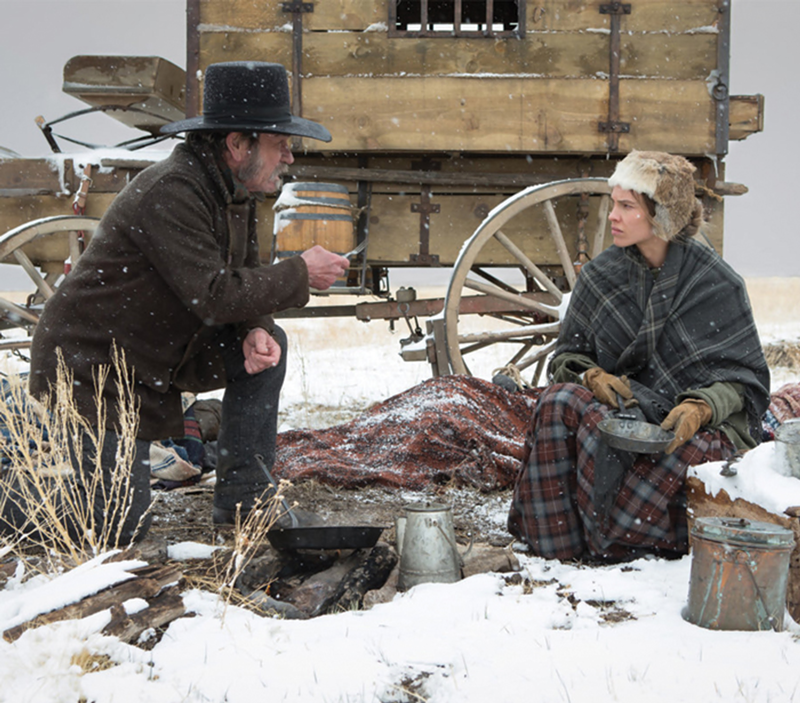Sometimes all an artist needs is the right muse, and in Mary Bee Cuddy, played by the ever-reliable period performer Hilary Swank, co-writer and director Tommy Lee Jones has found a distaff analogue that could be his spiritual twin. It is likely due to the source material. The Homesman, a novel by Glendon Swarthout, cannily sets up a premise with its protagonists — Cuddy (Swank) and ornery fugitive George Briggs (Jones) — embarking on an epic Western journey in reverse, bucking practical expectations. Fighting against such forces is what we’ve come to appreciate about Jones, his characters and his emerging role as a behind-the-scenes filmmaker.
As a writer and director, Jones has little interest in playing the conventional Hollywood games of spitting out disposable cookie-cutter products for mass consumption; he’s firmly ensconced in the slow cooking organic fringe, and audiences would be wise to seek out the sustaining comforts he concocts. He’s a rugged man of the land, so it is no surprise that The Homesman, set in the Old West, features characters seasoned on those harsh plains.
Cuddy, a more than capable spinster, agrees to transport a trio of mentally unstable women from Nebraska to Iowa, and enlists the aid of Briggs (who she finds struggling to keep a precious toehold on life) on the perilous journey. Early on, when we first meet Cuddy, she is intent on wooing a compatriot on the wild frontier, making a case for her desirability as a partner and mate. She’s sitting on a plot of land, which she tends on her own. She lives independently, canning and cooking off what she produces. She’s intelligent and well-read, a former teacher who would be able to pass those traits and that more developed skill set onto her offspring. But, even in those days, beauty mattered more and her less than plain appearance relegated her to the scrap heap, despite an otherwise sterling ledger.
Which, interestingly, sets up the primary contrast between Cuddy and Jones. Because she is a frontier woman, Cuddy lacks true agency in determining her own place and destiny, forcing her to make desperate choices, like taking on the responsibility of transporting the crew of mad women when no one else (i.e. none of the men in the community, the traditional “homesmen” who would have stepped up for the richly rewarded assignment) would. Later on, while in the midst of the trek, she brazenly propositions Briggs, bearing and inevitably humiliating herself once more as Briggs rebuffs her, only to relent out of what amounts to pity. It could be argued that not much has changed for women like Cuddy (or women in general) in today’s world.
Jones, though, has that plain, brutally honest approach we see in Cuddy, that stubborn desire to chart his own course and command his destiny. And it has served him well, on both sides of the camera. The four-time Academy Award nominee (who claimed the Best Supporting Actor prize in 1994 for his role in The Fugitive) has transformed his hardened face and demeanor into a rock-solid badge of honor without sliding into the kind of easy-to-label — and dismiss — brand (like, for instance, Clint Eastwood). Eastwood’s work behind the camera has certainly earned distinction, but his performances in front of it drifted toward caricature, while Jones was better able to sidestep such pitfalls.
It could be that we recognize an authentic mix of weary intelligence and a sadness that has not quite surrendered to hopelessness in Jones. There is a cynicism in him that informs not only his more heroic portrayals but also the darker characters in his filmography, although we cannot fail to acknowledge the dogged determination that ensures his characters will always soldier on until the end.
And nowhere is that more on display than in The Homesman. Cuddy and Briggs/Jones are a match made in the hallowed narrative halls of Hollywood’s Valhalla. Jones appreciates the journeys of lost souls, the herculean efforts necessary to get them safely to the other side, and he labors mightily to make sure audiences understand the stakes and the outcomes. Yet The Homesman, for all its allegiances to Old Western mythic storytelling — men and women versus nature and the darkness of the soul — is an intimate indie character study that benefits from Jones’ plain and raw authenticity.
Moreso than Eastwood’s celebrated revisionist Western, Unforgiven, The Homesman sets out to show us that the West was not won with blazing gun battles. Who is to say the West was “won” at all? Its stories are still being told, and we can only hope that a new generation of filmmakers like Jones will rise up to continue to spread the gospel. (Coming Soon) (R)


